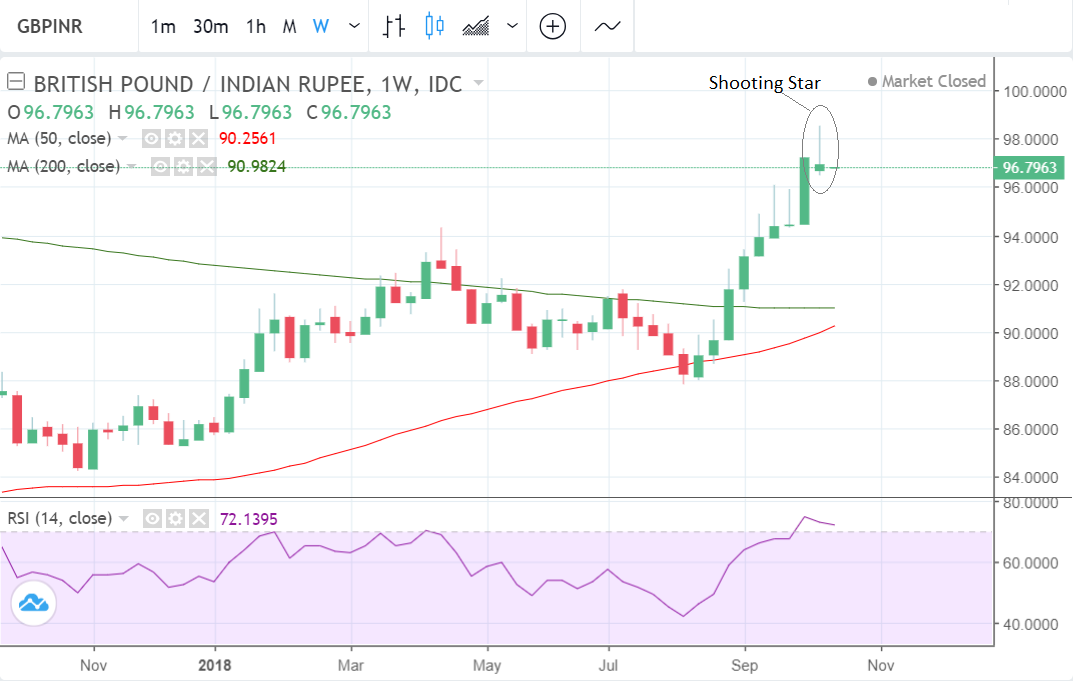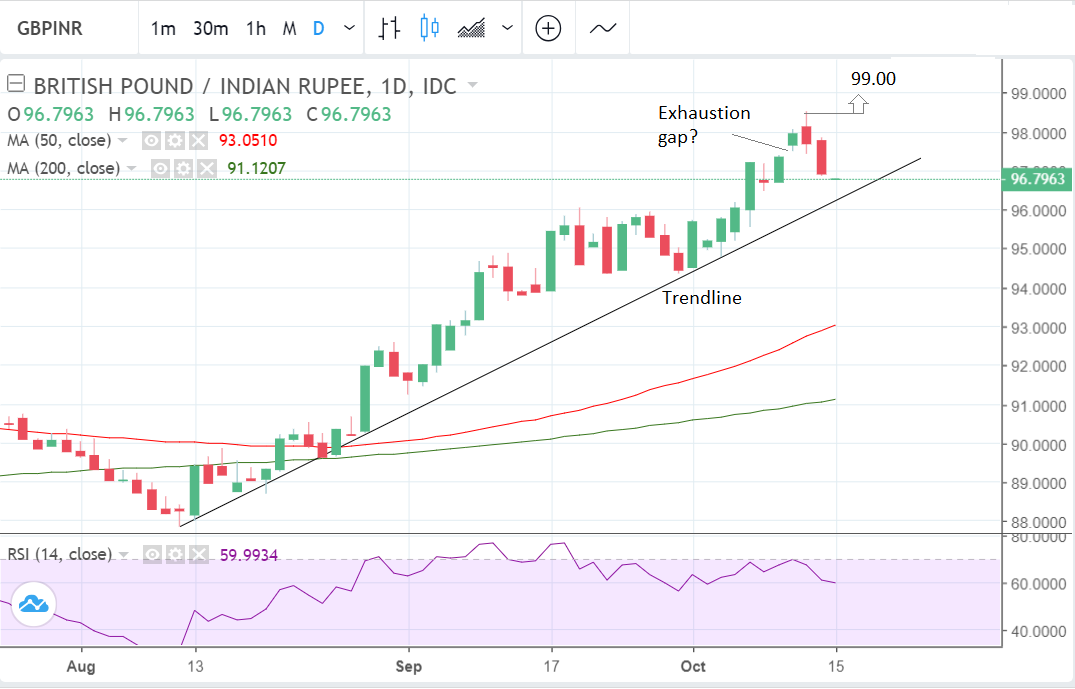Pound-to-Rupee Rate in the Week Ahead: GBP/INR Could be Topping Out

© Ash T Productions, Adobe Stock
- GBP/INR corrected lower after peaking in previous week.
- Uptrend to resume but also hints the pair may be topping.
- Brexit set to dominate GBP as the Rupee eyes wholesale inflation data.
The Pound-to-Rupee rate remains in an established technical uptrend and is quoted at 97.31 at the time of writing.
Although the pair corrected lower last week, there is a strong chance this weakness will be short-lived and that the pair's uptrend will resume in time.
However, further technical studies also suggest the potential for a top being formed in the exchange rate which certainly makes for an interesting development. This is something to be wary of.
GBP/INR has almost reached the trendline from which the up-move started back in August, at around the 96.50 level. This is a potential rotation level where prices could pivot higher and from which the uptrend may resume.
We see a good chance the trend will extend higher following any break above the 98.52 highs. Such a move would target the 99.00 level next.
But there are two concerning features of the charts make us wary of being overly bullish however, and could even indicate that a top is forming for the exchange rate.
The first is the shooting star candlestick pattern on the weekly chart, which is a bearish indicator for the pair. This would be confirmed if it is followed by a bearish candle.

Above: Pound-to-Rupee rate shown at weekly intervals.
Another sign that GBP/INR could be showing signs of peaking is the possible 'exhaustion gap' on the daily chart. These tend to form in the terminal stages of a trend and are often harbinger of a reversal in the primary trend.
A break below the trendline in the 96 area on a closing basis would be necessary to negate our bullish view of the established trend.

Above: Pound-to-Rupee rate shown at daily intervals.
Advertisement
Get up to 5% more foreign exchange by using a specialist provider to get closer to the real market rate and avoid the gaping spreads charged by your bank when providing currency. Learn more here
The Indian Rupee: What to Watch
The only release of note for the Rupee in the week ahead is wholesale price inflation, which is forecast to have risen by 4.9% during September, up from 4.53% in August.
Higher wholesale inflation could filter through into consumer prices, which are important for central bank policy and the Rupee, so the release could impact the Indian unit in theory although probably not in a big way.
Figures out last week showed that consumer price inflation disappointed in September, falling from 3.77% to 3.69%, whilst core inflation fell from 6.0% to 5.8%.
The Rupee fell after the data was released because it lessened the probability that the Reserve Bank of India (RBI) would hike interest rates again in 2018. Hhigher interest rates tend to attract greater inflows of foreign capital, driving up demand and the value of a currency in the process - and vice-versa for lower interest rates.
Another major driver of the Rupee is the price of oil, which the Rupee is negatively correlated to. India has to import most of its energy so the price of oil can, impact on the balance of payments, which has implications for the Rupee.
Recently India's trade and current account deficits have both widened almost exclusively because of the rise in oil prices and 2018's 15% devaluation of the Rupee.
Last week, however, WTI fell from $77pb to $71pb in an extremely sharp decline. If oil continues along this path in the week ahead it could be a positive factor for INR.
Advertisement
Get up to 5% more foreign exchange by using a specialist provider to get closer to the real market rate and avoid the gaping spreads charged by your bank when providing currency. Learn more here
The Pound: What to Watch
Brexit headlines will continue to drive the Pound in the week ahead.
U.K. Brexit minister Dominic Raab will travel to Brussels on Monday for a meeting with E.U. chief negotiator Michel Barnier, probably to agree on the final proposals to put before E.U. leaders at their crunch summit on Wednesday, October 17-18.
The outcome of the summit is expected to be a key driver for the Pound in the week ahead. If there is concrete progress on a withdrawal deal Sterling is likely to surge higher; if, on the other hand, there is no progress the Pound will fall.
Analysts at FX broker XM are rather pessimistic about the possibility of a major breakthrough:
"As it is standard for all E.U. negotiations to last into the last minute, the remaining issues are unlikely to be resolved at the E.U. heads of government summit on October 17-18 and the talks will probably continue into November when a special summit is being planned."
XM adds that "a worst-case scenario would be for Prime Minister May to secure a deal that has little chance of getting approved by the British parliament."
Indeed, weekend headlines have been troubling for the Prime Minister with reports that the cabinet are being urged to stage a mutiny on May's plans.
The big problem lies with a backstop clause that would trigger if the E.U. and U.K. fail to reach a trade deal during the two year transition period. There is talk that the backstop could apply to the whole U.K. and not just Northern Ireland, as had been the original proposal.
It is believed that Prime Minister May is willing to allow this transition to last indefinitely; something fiercely opposed by Brexit supporting MPs in the Conservative party. Should a time limit be agreed the opposition to May might fade and she will be able to push legislation through parliament.
There are several major releases in the week ahead but probably the most important is broad inflation data in September, which is forecast to show a 2.6% rise compared to a year ago and a 0.2% rise compared to a month ago, when it is released on Wednesday at 9.30 B.S.T.
Core inflation, meanwhile, is forecast to show a 2.0% rise compared to a year ago.
Inflation informs central bank policy and, crucially for FX, whether they put up interest rates; these in turn impact on exchange rates. A higher-than-expected rise in inflation would increase pressure on the Bank of England to raise interest rates and support the Pound.
The other major release in the week ahead for the Pound is employment and wage data, out on Tuesday at 9.30.
The unemployment rate is expected to remain at 4.0% in August. Average pay excluding bonuses is expected to have climbed by 2.9%, and pay including bonuses to have increased by 2.6%.
Market participants will be particularly focused on whether pay has increased more than expected - if it has the Pound could rise - as this will raise the outlook for inflation.
The third major release for Sterling in the week ahead is retail sales out at 9.30 on Thursday.
Retail sales have been fairly resilient but in September they are forecast to show a -0.3% drop (from 0.3% in August) but, nevertheless, a 3.7% rise compared to September last year. A higher-than-expected result would probably support the Pound as it suggests greater growth, inflation, and higher interest rates which are usually favourable for a currency.
Finally the weekends with a speech by the governor of the Bank of England (BOE) Mark Carney on Friday, at 16.30, which has been earmarked by some as a possible time for the Uk authorities to announce progress on securing trade deal with the EU.
Advertisement
Get up to 5% more foreign exchange by using a specialist provider to get closer to the real market rate and avoid the gaping spreads charged by your bank when providing currency. Learn more here
